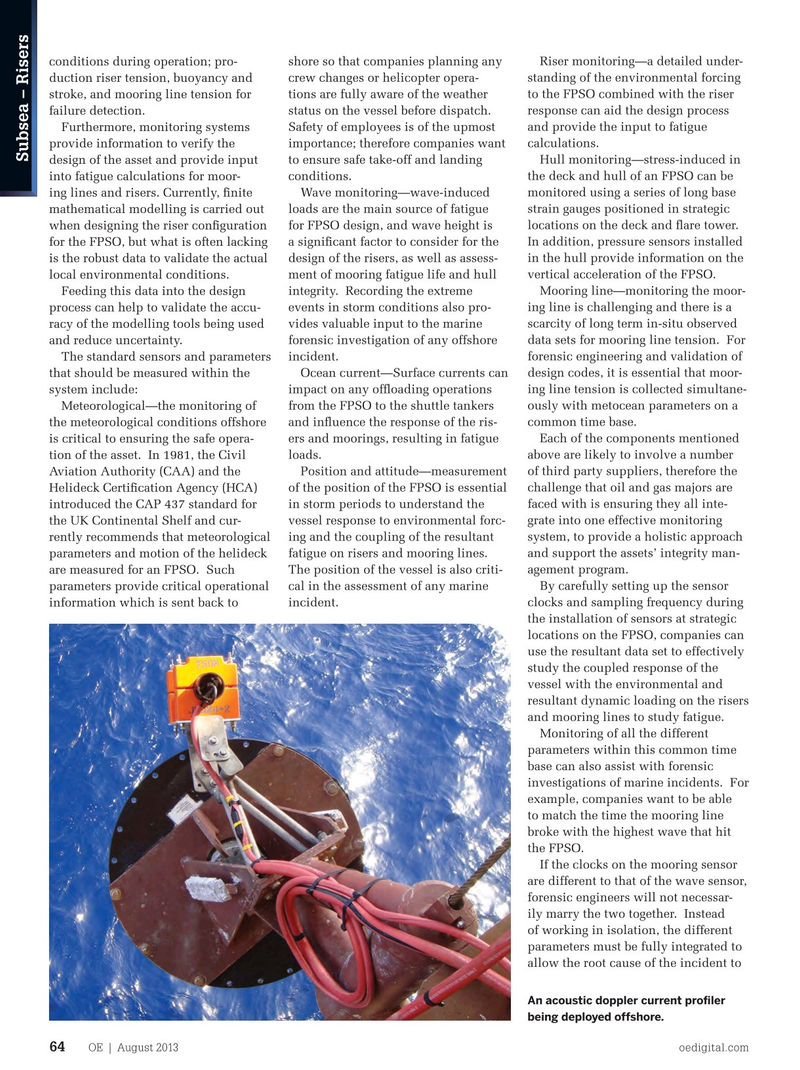
Page 62: of Offshore Engineer Magazine (Aug/Sep 2013)
Read this page in Pdf, Flash or Html5 edition of Aug/Sep 2013 Offshore Engineer Magazine
conditions during operation; pro- shore so that companies planning any Riser monitoring—a detailed under- duction riser tension, buoyancy and crew changes or helicopter opera- standing of the environmental forcing stroke, and mooring line tension for tions are fully aware of the weather to the FPSO combined with the riser failure detection. status on the vessel before dispatch. response can aid the design process
Furthermore, monitoring systems Safety of employees is of the upmost and provide the input to fatigue provide information to verify the importance; therefore companies want calculations.
Subsea – Risers design of the asset and provide input to ensure safe take-off and landing Hull monitoring—stress-induced in into fatigue calculations for moor- conditions. the deck and hull of an FPSO can be ing lines and risers. Currently, fnite Wave monitoring—wave-induced monitored using a series of long base mathematical modelling is carried out loads are the main source of fatigue strain gauges positioned in strategic when designing the riser confguration for FPSO design, and wave height is locations on the deck and fare tower. for the FPSO, but what is often lacking a signifcant factor to consider for the In addition, pressure sensors installed is the robust data to validate the actual design of the risers, as well as assess- in the hull provide information on the local environmental conditions. ment of mooring fatigue life and hull vertical acceleration of the FPSO.
Feeding this data into the design integrity. Recording the extreme Mooring line—monitoring the moor- process can help to validate the accu- events in storm conditions also pro- ing line is challenging and there is a racy of the modelling tools being used vides valuable input to the marine scarcity of long term in-situ observed and reduce uncertainty. forensic investigation of any offshore data sets for mooring line tension. For
The standard sensors and parameters incident. forensic engineering and validation of that should be measured within the Ocean current—Surface currents can design codes, it is essential that moor- system include: impact on any offoading operations ing line tension is collected simultane-
Meteorological—the monitoring of from the FPSO to the shuttle tankers ously with metocean parameters on a the meteorological conditions offshore and infuence the response of the ris- common time base.
is critical to ensuring the safe opera- ers and moorings, resulting in fatigue Each of the components mentioned tion of the asset. In 1981, the Civil loads. above are likely to involve a number
Aviation Authority (CAA) and the Position and attitude—measurement of third party suppliers, therefore the
Helideck Certifcation Agency (HCA) of the position of the FPSO is essential challenge that oil and gas majors are introduced the CAP 437 standard for in storm periods to understand the faced with is ensuring they all inte- the UK Continental Shelf and cur- vessel response to environmental forc- grate into one effective monitoring rently recommends that meteorological ing and the coupling of the resultant system, to provide a holistic approach parameters and motion of the helideck fatigue on risers and mooring lines. and support the assets’ integrity man- are measured for an FPSO. Such The position of the vessel is also criti- agement program. parameters provide critical operational cal in the assessment of any marine By carefully setting up the sensor information which is sent back to incident. clocks and sampling frequency during the installation of sensors at strategic locations on the FPSO, companies can use the resultant data set to effectively study the coupled response of the vessel with the environmental and resultant dynamic loading on the risers and mooring lines to study fatigue.
Monitoring of all the different parameters within this common time base can also assist with forensic investigations of marine incidents. For example, companies want to be able to match the time the mooring line broke with the highest wave that hit the FPSO.
If the clocks on the mooring sensor are different to that of the wave sensor, forensic engineers will not necessar- ily marry the two together. Instead of working in isolation, the different parameters must be fully integrated to allow the root cause of the incident to
An acoustic doppler current profler being deployed offshore.
OE | August 2013 oedigital.com 64 063_OE0813_Subsea1-Risers.indd 64 7/22/13 12:49 AM

 61
61

 63
63